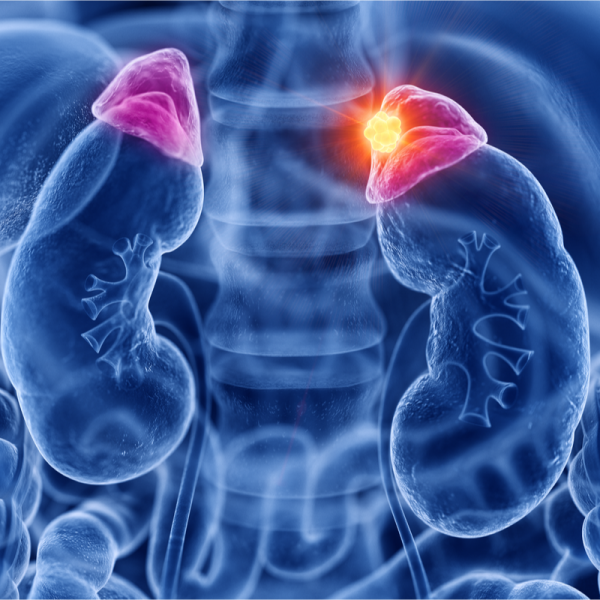
What is adrenocortical cancer?
Adrenocortical cancer or adrenocortical carcinoma is the name given to an extremely rare, highly malignant (highly malignant) tumour. Adrenocortical carcinoma can develop from any of the three layers of the adrenal cortex. The disease can occur at any age, but more often than average affects people in childhood or in their fourth and fifth decade of life. Women usually suffer from the disease slightly more often than men.
What causes adrenocortical cancer?
The exact causes of adrenocortical cancer are still unknown. However, doctors assume that adrenogenital syndrome could play a role in the development of the disease. This is a congenital disorder that affects hormone production in the adrenal cortex. In addition to adrenogenital syndrome, gene mutations, especially of the p53 oncogene gene, may also play a role. Researchers have come to this conclusion because they have observed a high percentage of this gene mutation within the tumours.
What symptoms does adrenocortical cancer cause?
Adrenocortical carcinoma causes symptoms mainly because of its size, but also because of its hormone secretion. It is mainly the hormone release of the stress hormone cortisol that can lead to the so-called Cushing's syndrome, which affects about half of all patients with adrenal carcinoma. The following symptoms are possible with Cushing's syndrome:
- Change in body shape, which is caused by weight gain, especially fat distribution on the abdomen and chest (truncal obesity), in the neck area (formation of a so-called bull neck) and in the face (formation of hamster cheeks or a full moon face), but also by water retention;
- thin arms and legs as a result of muscle wasting;
- Development of reddish stretch marks on the abdomen, hips and armpits, which can resemble stretch marks;
- Development of bruises due to poorer wound healing;
- Changes in the appearance of the skin, for example acne or the formation of thin parchment skin;
- menstrual irregularities;
- Mood swings or psychological changes, such as depressive thoughts or anxiety;
- Development of high blood pressure (hypertension);
- Development of diabetes mellitus;
- more frequent bone fractures due to increasing bone loss (osteoporosis)
Due to the development of Cushing's syndrome, male hormones (androgens) can often be detected in increased amounts. Due to these hormones, women develop hair growth on the face and body and/or a deep voice. If, on the other hand, an adrenocortical carcinoma does not secrete hormones, the tumour is usually diagnosed on the basis of its size. By growing into the neighbouring tissue, even a hormonally inactive tumour can cause the following rather unspecific complaints:
- Feeling of pressure and/or pain in the upper abdomen,
- increasing tiredness and/or fatigue,
- decreased physical performance,
- sudden nausea with or without nausea,
- unwanted weight loss
How is adrenocortical cancer diagnosed?
After taking a medical history, the patient is physically examined. This mainly involves palpation of the abdomen to check the size and location of the organs. In addition, the physique, musculature and skin are examined in order to detect signs of masculinisation in women. In addition to checking the blood pressure, the usual imaging procedures are carried out using magnetic resonance imaging (MRI) or computer tomography (CT). If adrenal carcinoma is detected, a tissue sample is usually taken for microscopic analysis.
When diagnosing adrenocortical cancer, the main focus is also on determining the hormone produced by the adrenal gland. Therefore, a catecholamine is carried out in which the parameters adrenaline, noradrenaline as well as dopamine are checked. In this way, the presence of a tumour in the adrenal medulla (pheochromocytoma) is to be excluded.
Which tumour stages are distinguished?
The tumour stage of adrenal carcinoma is decisive for further treatment, but also for the prognosis prospects. According to the classification of the "European Network for the Study of Adrenal Tumours" (ENSAT), the tumour is divided into the following stages:
- Stage I: The tumour is smaller than five centimetres and is limited to one adrenal cortex.
- Stage II: The tumour is larger than five centimetres, but is still limited to the adrenal cortex.
- Stage III: The tumour is no longer limited to the adrenal cortex, has formed lymph node metastases and/or blood clots in vessels such as the vena cava and/or has grown into the surrounding tissue.
- Stage IV: The tumour has formed distant metastases in other organs (usually the lungs or liver).
How is adrenocortical cancer treated?
In adrenocortical cancer, the first treatment option is always to try to remove the tumour completely. If the tumour has already spread to metastases, these should also be removed to prevent increased hormone levels. In addition to surgery, adjuvant therapy with so-called mitotans can also be carried out. Mitotanes are a substance that is approved for the drug treatment of adrenal carcinoma and also has an effect on tumour growth and hormone release of the adrenal cells. The adjuvant therapy described here should be given over a period of at least two years. Depending on the size of the tumour, radiation therapy can also be used as an alternative to surgery.
What is the aftercare for adrenocortical cancer?
After the operation, the patient should have check-ups every three months for the next two years. In addition to a clinical check-up, sectional imaging and hormone diagnostics are also carried out during the check-up. If the tumour detection is negative, the check-ups can also take place at intervals of four months. After five years without tumours, check-ups every six months are sufficient. Since adrenal carcinoma generally has a high recurrence rate, regular follow-up examinations are recommended for a total of ten years.
What is the prognosis for adrenocortical carcinoma?
The course of the disease, but also the prospects of cure, depend on the tumour stage at which the disease was diagnosed. While stage I has a relatively good prognosis, stages II to IV have increasingly poor healing prospects.
